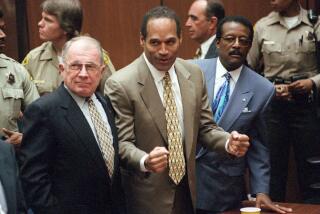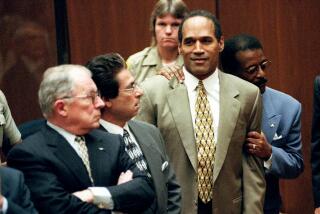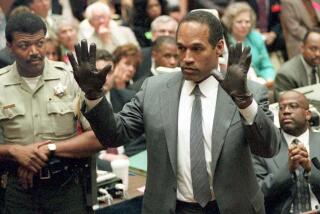Simpson Team Depends on Data for the Defense : Law: Robert Shapiro and Robert Blasier bring their laptop computers to CSUN to teach a lesson in high-tech lawyering.
- Share via
NORTHRIDGE — However else the O. J. Simpson trial may affect jurisprudence in the United States, it has offered a preview of the kind of cutting-edge computer technology that will become more common in future proceedings.
That’s the view of two members of the Simpson defense team who shared their experiences with 130 computer students at Cal State Northridge Wednesday night.
Robert Shapiro and Robert Blasier said that the defense’s sophisticated use of technology has proved an advantage in the case--but has also caused its share of problems.
“You oftentimes will see O. J. or me or Bob conferring very seriously, looking down, talking very seriously like we’re doing something important. And it’s usually Bob saying, ‘How do I get rid of this dialogue box on my computer?” Blasier said, provoking laughter from the students.
Added Shapiro: “Prior to this case, I was a computer-illiterate. So most of the time when people ask, ‘What are you doing in the courtroom?’ I am sitting there learning the different programs that Mr. Blasier has installed on my computer.”
During a two-hour seminar on technology in the courtroom, the attorneys said the use of computer technology in the Simpson trial “has changed the way law is practiced.”
For example, the defense team has captured almost the entire yearlong murder case on an NEC laptop computer that Blasier uses in court, he said, by merging the vast volumes of testimony with thousands of electronically scanned pages of exhibits and pictures along with a virtual law library.
On any given day, Blasier said, the defense team will use as many as 11 software programs in court, including one that quickly prepares computer-generated slide shows of evidence. And Blasier said Simpson has taken to the technology. “O. J. loves the computer,” he said.
Part of the setup, which Blasier said Superior Court Judge Lance A. Ito and prosecutors do not use, is an indexed and searchable computer version of the trial’s transcript, allowing quick comparisons of witnesses’ current testimony with what they have said previously.
“I think it’s been a tremendous advantage being able to find things in the transcript very quickly,” Blasier said. “We’ve had nine months of testimony. And it’s very difficult to remember from one day to the next what somebody said.”
Prosecutors, Blasier said, haven’t made as much use of technology as the defense has. “I know they haven’t because sometimes they come over and ask me to find something, too.” The defense has offered the software to Ito, but Blasier believes the judge has not been using it on his laptop.
However, Sandi Gibbons, a spokeswoman for the Los Angeles County district attorney’s office, said prosecutors have access to much of the same information on their desktop computers in the courtroom. “We do the same things with ours that they do with theirs,” Gibbons said.
Not that all that technology always works perfectly. Blasier said a system called Trial Link, which displays and allows the manipulation of data related to evidence, has been used only sparingly. “The reason no one has used it except me is that everyone is terrified of it,” he said.
Shapiro added that Blasier joined the defense team after a six-month computerization effort costing hundreds of thousands of dollars proved an utter failure. “I turned to the computer expert and asked him to pull up a subject, and we couldn’t get any data out,” Shapiro said.
Yet Blasier said he too has fallen victim to technology, losing data on his laptop’s hard disk because of a data-compression program and losing the use of the machine for a week because of problems in the installation of Microsoft’s new Windows 95 operating system.
And not all of the defense attorneys are convinced that computers are in their future, he said. Recently, when Blasier’s laptop was down and another computer wasn’t working, attorney Gerald Uelmen quipped, “You know, I dropped my legal pad on the floor the other day--and I just picked it up.”
More to Read
Sign up for Essential California
The most important California stories and recommendations in your inbox every morning.
You may occasionally receive promotional content from the Los Angeles Times.













